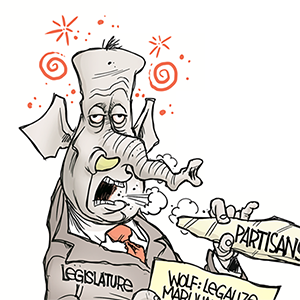Analysis: Is the House battleground going back to the future?
Published in Political News
WASHINGTON — A secret of political handicapping is that how a district has voted in the past is a pretty good indicator of how it will vote in the future.
But while the most recent presidential election is typically a good measure of a House seat’s partisan performance, this month’s off-year election results showed that the 2020 presidential race might be a better baseline to evaluate what might happen in 2026.
Even though 2020 was a half-decade ago, there are similarities to the present time. Donald Trump is back in the White House, and his job approval rating is mediocre. And under those conditions, House Democrats are better positioned to win the majority in the midterm elections.
Yes, Democrats won Democratic areas in the biggest races earlier this month, but the margins were important to evaluate whether Republican candidates could maintain the coalition that Trump assembled to get elected in 2024.
The results show that experiment didn’t go well for Republicans.
While Trump pulled within 6 points of Kamala Harris in New Jersey in 2024, Republican Jack Ciatterelli lost to Democratic Rep. Mikie Sherrill by 14 points in this year’s race for governor. That was closer to Trump’s 16-point loss to Joe Biden in the Garden State in 2020.
Trump lost Virginia by 6 points in 2024, but Republican Lt. Gov. Winsome Earle-Sears lost the commonwealth’s gubernatorial contest to Democratic former Rep. Abigail Spanberger by 15 points. That was worse than Trump’s 10-point loss in 2020.
And in California, Trump pulled to within 20 points of Harris in 2024 and yet Proposition 50, the Democratic redistricting effort, passed statewide by 29 points, a near-identical margin to Biden’s in the Golden State in 2020.
Assuming Trump’s standing doesn’t dramatically improve, how would the House battlefield change if the political environment was closer to 2020 than to 2024?
According to Inside Elections, there are currently 192 races rated Solid Republican and 180 rated Solid Democratic. When the 63 seats rated competitive are allotted to each party based on how they voted in the 2024 presidential elections, Republicans finish with a 228-207 majority. When those same competitive seats are allotted based on 2020 presidential results, Democrats finish with 223 seats to Republicans’ 212. The magic number for a majority is 218.
It’s an admittedly crude tabulation considering there are a handful of members, such as GOP Reps. Brian Fitzpatrick of Pennsylvania’s 1st District and Mike Lawler of New York’s 17th and Democratic Reps. Marie Gluesenkamp Pérez of Washington’s 3rd and Marcy Kaptur of Ohio’s 9th, who have demonstrated the ability to win in districts where their party otherwise doesn’t do well. But they are exceptions rather than the rule.
The difference between the 2020 and 2024 scenarios is fueled by 16 districts where Trump finished ahead of Harris in 2024, but where Biden finished ahead of Trump in 2020.
Those 16 seats are split down the middle, with each party holding eight of them.
The Republican seats are Arizona’s 1st (currently represented by Rep. David Schweikert) and 6th (Juan Ciscomani), California’s 22nd (David Valadao), Colorado’s 8th (Gabe Evans), Michigan’s 7th (Tom Barrett), New Jersey’s 7th (Thomas H. Kean Jr.), Pennsylvania’s 7th (Ryan Mackenzie) and Virginia’s 2nd (Jen Kiggans).
The Democratic-held seats include Michigan’s 8th (Kristen McDonald Rivet), Nevada’s 3rd (Susie Lee), New Jersey’s 9th (Nellie Pou), New Mexico’s 2nd (Gabe Vasquez), New York’s 3rd (Tom Suozzi), Ohio’s 1st (Greg Landsman) and Texas’ 28th (Henry Cuellar) and 34th (Vicente Gonzalez).
And those aren’t the only seats to watch.
If the 2020 presidential results are indeed a more appropriate baseline, then another set of GOP-held districts could push closer to the core of the battlefield. Trump carried eight districts with 51% or less in 2020, including Iowa’s 1st (Mariannette Miller-Meeks), 2nd (Ashley Hinson) and 3rd (Zach Nunn); Michigan’s 4th (Bill Huizenga) and 10th (John James); Pennsylvania’s 8th (Rob Bresnahan Jr.) and 10th (Scott Perry); and Wisconsin’s 1st (Bryan Steil).
Trump would have also carried Texas’ 15th (Monica De La Cruz) with just 51% in 2020 under the map state Republicans drew earlier this summer, but that map is on hold following a court order Tuesday. Republicans are appealing the decision.
And still another batch of six seats could make their way from the fringe of the battlefield to truly competitive in 2026. Trump finished with just 52% or 53% in Alaska’s At-Large District (Nick Begich), Arizona’s 2nd (Eli Crane), Colorado’s 5th (Jeff Crank), Florida’s 13th (Anna Paulina Luna), Virginia’s 1st (Rob Wittman) and Wisconsin’s 3rd (Derrick Van Orden).
When Democratic candidates and proposals are consistently outperforming the 2024 presidential performance by at least 6 to 9 points, we could be seeing an overall shift in the House battlefield, rather than incremental changes by district.
Overall, if Republican redistricting efforts continue to stall and the fall of 2026 looks anything like the fall of 2025 or 2020, House Democrats will likely gain the three seats they need for a majority, and it may not be close.
©2025 CQ-Roll Call, Inc., All Rights Reserved. Visit cqrollcall.com. Distributed by Tribune Content Agency, LLC.
























































Comments